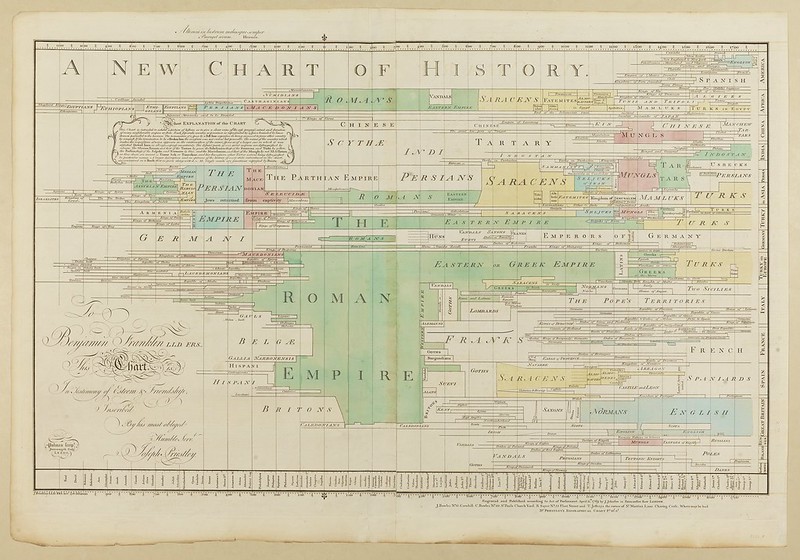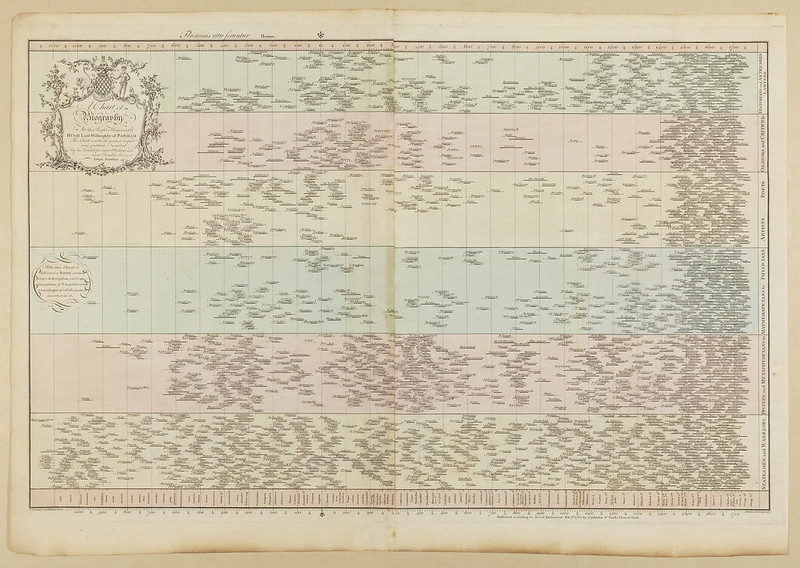World History Timeline
This post may contain affiliate links. As an Amazon Associate, we earn from qualifying purchases.
The World History Timeline Graph is a comprehensive visual representation of significant events and developments throughout human history, presented in chronological order. It typically spans from ancient civilizations to modern times, highlighting key moments in politics, culture, science, technology, and more. This timeline graph provides a valuable overview of the progression of human civilization, allowing viewers to understand the interconnectedness of historical events and their impact on shaping the world we live in today.
Table of Contents
The first attempt (1769) at creating World History Timeline belongs to the British polymath Joseph Priestley.
A New Chart of History (1769)
A poster he created called ‘New Chart of History’ shows empires’ continuation to give learners a more global picture of history across space and time.
The Chart of History poster chronicles milestones in 106 separate locations. The map poster depicts Priestley’s idea that the whole world’s history was important.
The world’s history poster is split into the following geographical sections: Great Britain, Russia, Poland, Germany, France, Italy, Spain, Turkey, Persia, India, China, Africa, and America.

Also, Joseph Priestley created a chart in which he depicted famous personalities who influenced history.
A Chart of Biography (1765)
Timeline poster about influential persons created by Joseph Priestley called ‘The Chart of Biography’.
The Chart of Biography (1765) covers a broad period, from 1200 BC to 1800 AD, and holds 2,000 names. Joseph Priestley created his list into 6 categories:
- Statesman and Warriors
- Divines and Metaphysicians
- Mathematicians and Physicians (including philosophers)
- Poets and Artists
- Orators and Critics
- Historians and Antiquarians (including lawyers)
He tried to list them in the category under which their most significant work had been done (for example, Machiavelli is listed as a historian first than a statesman). The chart poster was also arranged in order of importance.

Since then, many attempts have been made to depict countries and their time of existence and the lifetime of influential historical figures on one map. Here is one of the most magnificent modern attempts to present all the events of world history in one chronological sequence.
Displaying 4000 Years of History: A 5-Foot-Long “Histomap” from 1931
In 1931, John B. Sparks collaborated with Rand McNally to publish a five-foot-long chart known as the Histomap, which aimed to encapsulate 4,000 years of “world” history. This visual representation effectively illustrates the ebb and flow of different states, nations, and empires over time.
Determining a singular world leader at specific points in history is relatively straightforward. However, allocating influence or power across 4,000 years to every entity requires a degree of creativity and likely involves some degree of guesswork. Some critics argue that the lack of concrete data makes it impossible to draw definitive conclusions, although there have been other more quantitative methodologies employed in historical analysis.
One prominent criticism is the perceived bias towards Western powers in the measurement of influence. For example, China’s representation on the chart appears disproportionately minimal throughout the timeline. The creator’s biases and limitations become more evident when viewed through the lens of the information-rich 21st century.

Furthermore, the terminology used to describe various cultural and racial groups in the Histomap may seem outdated to contemporary viewers. Despite this, Sparks’ map remains a compelling historical document because of its unique approach. While his focus on racialism and imperial conquest might align him with populist “scientific” racists of his era, such as Lothrop Stoddard (referenced by Tom Buchanan in Fitzgerald’s The Great Gatsby), it also reflects a design philosophy reminiscent of early Enlightenment thinkers. These figures, like Thomas Hobbes, often conceived of historical epochs as the rising and falling actions of different groups, rather than a linear progression towards a predetermined end.
World History Timeline
It is impossible to show everything that has happened in world history on a small map poster. Nevertheless, the central part of the modern version of the world history timeline poster shows the rise and fall of the all great empires and nations throughout history. It is arranged according to continents, and where possible continents that are next to each other on the globe are next to each other on the map poster. It shows how people moved out of their homeland to conquer new territories, sometimes far from home. Each continent is shown in a limited color range. For example, Europe if red-orange-yellow. You can easily see when a European state took control of a country outside Europe because its color remains ‘European’ even though it is outside Europe. The length of the color shows the length of time the empire lasted, and the width shows how extensive was the territory they controlled.
Aggressive states were not present everywhere at all times. In many parts of the world, people lived in small groups without making great conquests. While the conquering nations are shown with bold colors, the peaceful people are demonstrated in lighter colors. You will see that some of them existed for many hundreds of years.
The further we go back in time, the less we know about what happened. That is mainly because until writing was invented between 5000 and 4000 years ago (or much later in some areas), nobody could record events. This is the period we call ‘prehistory,’ where archaeology (digging up actual remains) is the mam source of our knowledge. There were probably just as many exciting events and people then, but the chart has more empty spaces because information about them is lost.
For this reason, the space allowed for each century gets smaller as we go back in time. Also, the space allowed for each continent is not proportional to its actual size – more space is given where most of the recorded history took place. Can you imagine what the Chart would look like if we allowed precisely the same space for each century and allowed space for each continent according to its actual area?

Below the main chart is a Timeline of important events and personalities in the past. These people and events have all influenced our world today – even though many of them are far distant in time. They include kings and queens, politicians, religious and cultural leaders, and inventors.
If you only want to dwell on historical figures, you’ll love the timeline poster created by Reddit user profound_whatever.
Who lived when?
To conclude this article, a simpler, modern Histomap would not be out of place.
The ‘Big Map of Who Lived When?’ poster overlaps the lives of historical figures from 1200 to the present.

If you liked these timeline posters, check out these posters as well.

Love that chart!